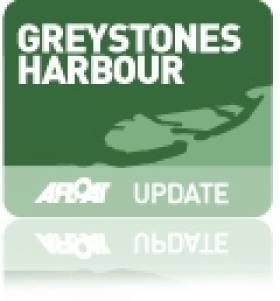Displaying items by tag: Sea Scouts
Sea Scout Conference In Cork Harbour Attended by 90% of Groups
#seascouts – The 2015 Sea Scouting conference was held last weekend based in the Commodore Hotel in Cobh. Over 90% of the country's Sea Scout groups were in attendance, with delegates from as far away as Donegal, Louth and Galway. Sea Scouting is a branch of Scouting Ireland which concentrates on the development of leadership skills through adventurous activities afloat, having being founded by Baden Powell's brother in the 1910s. Its members make up about 1 in 12 of Scouting Ireland's members.
The weekend's programme was packed with workshops and speakers, with Commodore Hugh Tully, Flag Officer Commanding the Naval Service opening the conference. Lieutenant Commander Martin Brett of the Naval Service gave the keynote speech at the dinner on Saturday evening. Lt Cdr Brett, who also the Venture Scout Leader in the 55th Cork (Carrigaline) spoke about leadership at sea and his presentation was a highlight of the weekend. Workshops included a presentation by Scouting Ireland's new Programme Commissioner for Youth Empowerment Niamh Donnelly, hands-on sessions including an exploration of inclusivity for young people with disabilities led by Ciaran Murphy from the ISA, a session on applying the Leave no Trace principles to activities afloat and talks on adventurous journeys including Finbarr Hedderman who spoke about his swim from Ireland to Scotland.
There was also a presentation from Sail Training Ireland. In conjunction with Sail Training Ireland, Sea Scouting launched an opportunity for all Scouts age 16-26 to join a Scout-only voyage from Falmouth to Belfast as part of the Tall Ships festival this summer.
Chief Scout of Scouting Ireland Michael John Shinnick also attended the gala dinner on the Saturday evening. In recognition of his support over the last 6 years as Chief Scout, he was presented with a framed photo of himself at the helm of Yahtzee, the well-known ISORA campaigner, which acted as committee boat at the 100th anniversary Sea Scout Rowing Regatta last year in Dun Laoghaire.
Programme Commissioner for Sea Scouting Stephen Taylor said about the conference: "We are at very exciting time for Sea Scouting with a number of new Sea Scout Groups opening around the country. We also have some ambitious projects in the pipeline that will see more and more young people enjoying fun and adventure on the water. The level of attendance at the conference and the spirit in which delegates engaged shows a bright future afloat."
Malahide Sailors Compete in International Sea Scout Regatta
#malahide – Two Malahide sailors, Gemma McDowell and Sarah McKernan, travel to the USA this week to represent Scouting Ireland and Malahide Yacht Club at the William I Koch International Sea Scout Sailing Regatta in Long Beach, California. The two scouts earned the right to compete by winning the Irish Scout Sailing Championship on the Broadmeadows last August.
The biennial regatta will see teams from Brazil, England, Ireland, Finland, Poland, Portugal, New Zealand, South Africa and Trinidad and Tobago square off against their American counterparts from a dozen states in a week of competition in Flying Junior sailboats. Gemma and Sarah will also compete as part of international eight-man crews on board Catalina 37s.
The week-long regatta will end with an awards dinner where America's Cup-winning skipper and philanthropist Bill Koch will present the Koch Cup to the winning team.
Scouting Ireland Sea Scout Commissioner, Stephen Taylor, will travel with the team along with Kate O'Farrell, team manager, and Colum McCaffrey who has coached the team.
Boat Stolen from Dollymount Sea Scouts Recovered by Gardaí
#STOLEN BOAT - Dollymount Sea Scouts have reported the recovery of a boat stolen from their scout den in north Dublin earlier this week.
The BP 18 standard boat was taken from outside the scout den at the Crow's Nest in Dollymount at some time between the hours of 5pm on Sunday 16 and 5pm on Monday 17 September.
But eagle-eyed gardaí in a patrol car from Santry spotted the boat in the driveway of a derelict house in a north Dublin housing estate.
The boat, Orion 2, was towed back to Santry Garda Station from where it was picked up by the sea scouts and brought home to Dollymount on Tuesday evening.
The brand new boat has a red fibreglass hull with brown varnished timber thwarts and gunwales, and is painted light grey inside. The boat is 18ft long and was last seen on its four-wheel trailer.
This type of boat is only used by Sea Scouts in Ireland and An Slua Muiri (Irish Navel Reserves). It has only been used a handful of times since its launch in May this year, and only one of this particular kind has been manufactured recently.
Greystones Harbour Open Day Gives Chance to See Impressive Marine Works
This is a chance, says local councillor Derek Mitchell, to see what has been achieved behind the hoardings in the last two years. "All marine works will be finished in 2010 and it is impressive to see what has been achieved. Currently much of the earth stored on top of D'Arcys field is being moved to beside the new harbour and it is quite mucky which limits the area which the public can access. However it will be a good chance to see behind the hoardings" Mitchell told Afloat.ie.
The next stage will start in January and finish in December 2011 after which most hoardings will come down. This stage consists of the 4 storey Health Centre, public square and free clubhouses for the Sea Scouts, Rowers, Divers, Sailors and Anglers.
Greystones Harbour Facilities to be Complete by End 2011
Tuesday nights Greystones Town Council meeting was informed by Greystones harbour developer Sispar that the major work on the seawalls would be complete at the end of November 2010.
Following this, construction of the Health Centre, public square and Community buildings for the Sea Scouts, Rowers, Anglers, Divers and Sailors will start in January and should be complete in December 2011.
The hoardings which have blocked the view of the harbour and proposed marina will be taken down as these works are completed in 2011.
Local councillor Derek Mitchell (and a Ruffian keelboat champion) told Afloat.ie: "I welcome this as Greystones had been trying to get the harbour rebuilt for over a hundred years and this will create the best Community Harbour in Ireland".
Councillor Mitchell adds "The developer has applied to change some of the housing and add 34 houses to the North. Wicklow County Council is to vote on this in December. These houses may not be built yet, depending on the housing market, but access will be provided across the site to the North Beach and the new swimming beach there"
"The meeting was also told that the loan would be going in to NAMA, as all loans will, however this is not expected to make any difference to the project", he added.
Councillors asked for more Community tours so that people could see what has been achieved.

































































